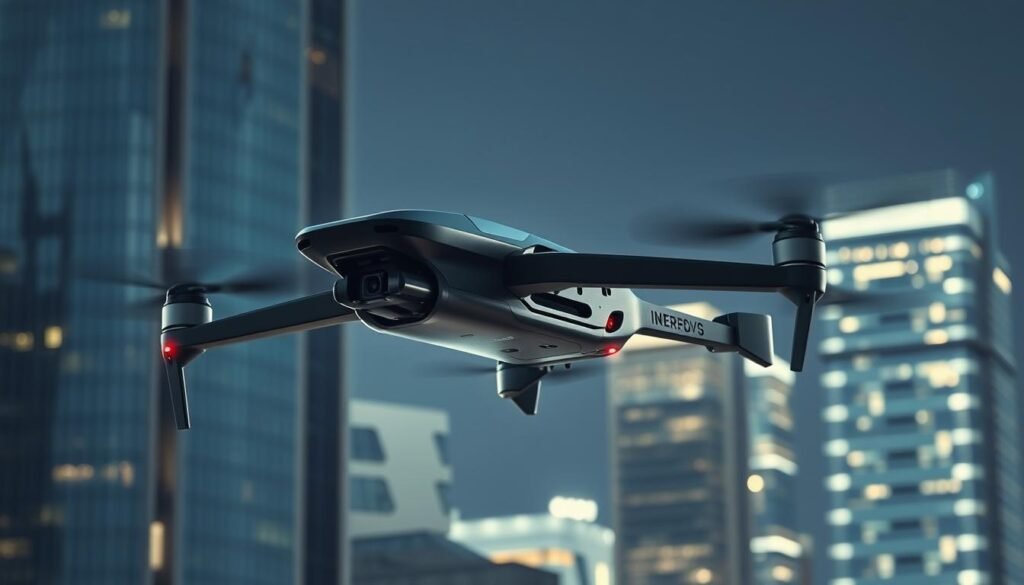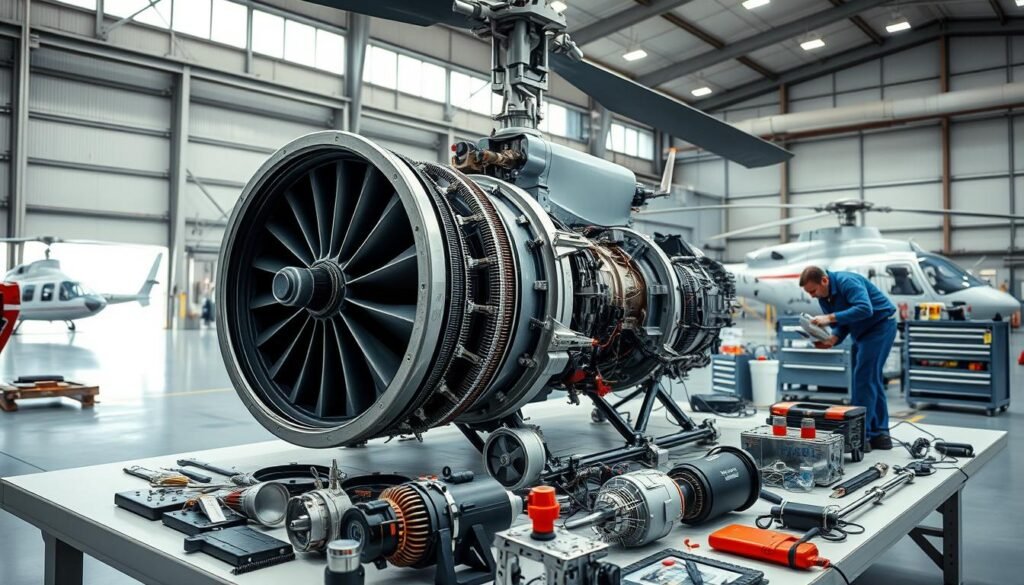Helicopter maintenance has long been a critical aspect of ensuring the safety, efficiency, and longevity of aircraft. Traditionally, maintenance schedules have been based on routine inspections and reactive repairs, but advancements in artificial intelligence (AI) and big data are revolutionizing this approach. AI and big data analytics are now enabling predictive maintenance, improving safety, reducing costs, and enhancing overall operational efficiency. In this article, we explore how AI and big data are shaping the future of helicopter maintenance and what this means for the aviation industry.
1. The Role of AI in Helicopter Maintenance
AI is transforming helicopter maintenance by automating data analysis, enabling predictive insights, and streamlining decision-making processes. Through machine learning algorithms and advanced analytics, AI systems can process vast amounts of data to identify patterns, predict potential failures, and optimize maintenance schedules.
A. Predictive Maintenance
Predictive maintenance is one of the most significant innovations AI brings to the aviation industry. By analyzing data from sensors installed on helicopters, AI algorithms can predict when a component is likely to fail or require service, allowing technicians to perform maintenance before a breakdown occurs.
- Early Fault Detection: AI-driven systems can identify anomalies in rotor blade performance, engine temperature, or other critical components, alerting technicians to potential issues before they become serious.
- Reduced Downtime: With predictive maintenance, helicopters spend less time grounded for unscheduled repairs, improving fleet availability and operational efficiency.
B. AI-Driven Diagnostics
AI systems can quickly diagnose issues by analyzing real-time data and comparing it to historical performance metrics. These systems can suggest optimal solutions or guide technicians through repair procedures.
- Faster Troubleshooting: Instead of relying on manual inspections and guesswork, AI systems can pinpoint the root cause of a problem with greater accuracy and speed, reducing repair time.
2. The Impact of Big Data on Helicopter Maintenance
Big data plays a crucial role in enhancing the effectiveness of AI systems by providing the vast amounts of information needed for accurate predictions and insights. Helicopters are equipped with sensors that monitor everything from engine performance to rotor blade vibrations, generating terabytes of data each flight. This data is used to improve maintenance processes in the following ways:
A. Data Collection and Integration
Modern helicopters are outfitted with numerous sensors that collect data on various systems, such as engine performance, fuel consumption, rotor blade health, and avionics. This data is then transmitted to central systems where it is analyzed.
- Sensor Data: Sensors monitor critical systems in real-time, capturing performance metrics and environmental conditions. This data is used to track wear and tear and detect abnormalities that could indicate potential issues.
- Historical Data: Big data systems compile historical performance data, which AI algorithms use to identify trends and predict future maintenance needs. By analyzing years of operational data, the system becomes increasingly accurate in its predictions.
B. Advanced Analytics for Optimized Maintenance
The integration of big data analytics allows maintenance teams to optimize their maintenance strategies, reduce costs, and improve efficiency. Instead of following rigid maintenance schedules, operators can now make data-driven decisions.
- Custom Maintenance Schedules: Big data allows operators to move from a “one-size-fits-all” approach to maintenance to customized schedules based on each helicopter’s usage and performance. This reduces unnecessary maintenance and extends the life of components.
- Cost Savings: By analyzing maintenance costs and failure patterns, big data can identify the most cost-effective time to replace parts or perform repairs, helping operators save money on parts and labor.
3. The Benefits of AI and Big Data in Helicopter Maintenance
The use of AI and big data in helicopter maintenance offers numerous benefits, from enhanced safety to improved operational efficiency. Here are some of the key advantages:
A. Enhanced Safety
The primary benefit of AI and big data in helicopter maintenance is improved safety. By detecting potential issues early and preventing unexpected failures, these technologies help reduce the risk of accidents.
- Early Warning Systems: AI-powered systems can alert operators to potential safety hazards, such as engine malfunctions or rotor blade fatigue, before they become critical. This ensures that helicopters are safe to operate at all times.
- Reduced Human Error: AI and big data reduce the reliance on manual inspections, which are subject to human error. Automated systems can analyze data more accurately and consistently, minimizing the risk of overlooking critical issues.
B. Increased Efficiency
AI and big data streamline maintenance processes, enabling faster repairs, optimized schedules, and reduced downtime. This increases the overall efficiency of helicopter operations.
- Optimized Fleet Management: With AI and big data, operators can better manage their fleets by predicting maintenance needs, minimizing downtime, and ensuring that helicopters are ready for use when needed.
- Reduced Grounding Time: Predictive maintenance allows technicians to address issues before they lead to breakdowns, minimizing the time helicopters spend grounded for repairs.
C. Cost Savings
While implementing AI and big data systems requires an upfront investment, the long-term cost savings are significant. Predictive maintenance reduces the frequency of unexpected repairs and extends the lifespan of helicopter components.
- Lower Maintenance Costs: By avoiding unnecessary maintenance and extending the life of critical components, operators can reduce maintenance costs over time.
- Improved Parts Inventory Management: Big data can help operators manage their parts inventory more efficiently by predicting when specific components will need to be replaced. This reduces the need for excess inventory and ensures that parts are available when needed.
4. Challenges of Implementing AI and Big Data in Helicopter Maintenance
While the benefits of AI and big data in helicopter maintenance are clear, there are challenges to implementing these systems. These challenges include the cost of implementation, data integration, and the need for skilled personnel.
A. High Initial Investment
Implementing AI and big data systems requires a significant upfront investment in sensors, data infrastructure, and software. However, these costs are often offset by long-term savings in maintenance and operational efficiency.
B. Data Integration
Integrating data from multiple systems can be challenging, especially for older helicopters that may not be equipped with modern sensors. Operators must ensure that their data infrastructure is capable of collecting, processing, and analyzing data from various sources.
C. Skilled Workforce
The use of AI and big data in helicopter maintenance requires a workforce that is skilled in data analytics, AI systems, and aviation technology. Operators may need to invest in training programs to ensure that their technicians can effectively use these systems.
5. The Future of AI and Big Data in Helicopter Maintenance
As AI and big data technologies continue to advance, their role in helicopter maintenance will only grow. Future developments will likely include more sophisticated AI algorithms, better integration with autonomous systems, and enhanced predictive models.
A. AI-Driven Autonomous Maintenance
In the future, AI systems may be able to autonomously perform certain maintenance tasks, such as diagnostics, repairs, or even part replacements. This would further reduce the need for human intervention and improve the efficiency of maintenance operations.
B. Enhanced Predictive Models
As AI systems are exposed to more data, their predictive capabilities will improve. This will allow for even more accurate predictions of component failures, reducing the risk of unexpected breakdowns and improving overall safety.
Conclusion
AI and big data are revolutionizing helicopter maintenance by enabling predictive maintenance, improving safety, reducing costs, and enhancing operational efficiency. By collecting and analyzing vast amounts of data, AI-driven systems can detect potential issues before they become critical, allowing operators to address problems proactively. While there are challenges to implementing these technologies, the long-term benefits make AI and big data a crucial part of the future of helicopter maintenance. As technology continues to evolve, the role of AI and big data in aviation will only become more integral to ensuring safe and efficient helicopter operations.
Related Articles
- Understanding Helicopter Vibration Analysis: Key to Preventing Major Failures
- How AI and Big Data Are Shaping the Future of Helicopter Maintenance
- Upgrading Helicopter Systems: When and Why to Modernize Your Aircraft
- The Importance of Regular Avionics Checks for Helicopter Performance
- Helicopter Maintenance in Extreme Weather Conditions: What Technicians Need to Know
More from This Category
- Digital Cockpits: How Modern Technology Is Transforming Helicopter Navigation
- The Role of Predictive Maintenance in Helicopter Fleet Management
- Innovative Materials in Helicopter Design: Enhancing Durability and Efficiency
- How Helicopter Technology Is Revolutionizing Emergency Response Operations
- Rotor Blade Maintenance: Why It’s Critical for Safe Flight
- The Future of Autonomous Helicopters: What Technology Holds for the Aviation Industry
- Helicopter Engine Maintenance: Best Practices for Longevity and Efficiency
- How Advances in Avionics Are Improving Helicopter Safety and Performance
- Routine Helicopter Maintenance Checklist: What Every Pilot Should Know
- The Evolution of Helicopter Technology: From Early Models to Modern Innovations



